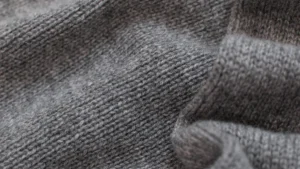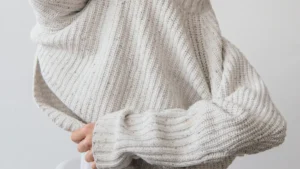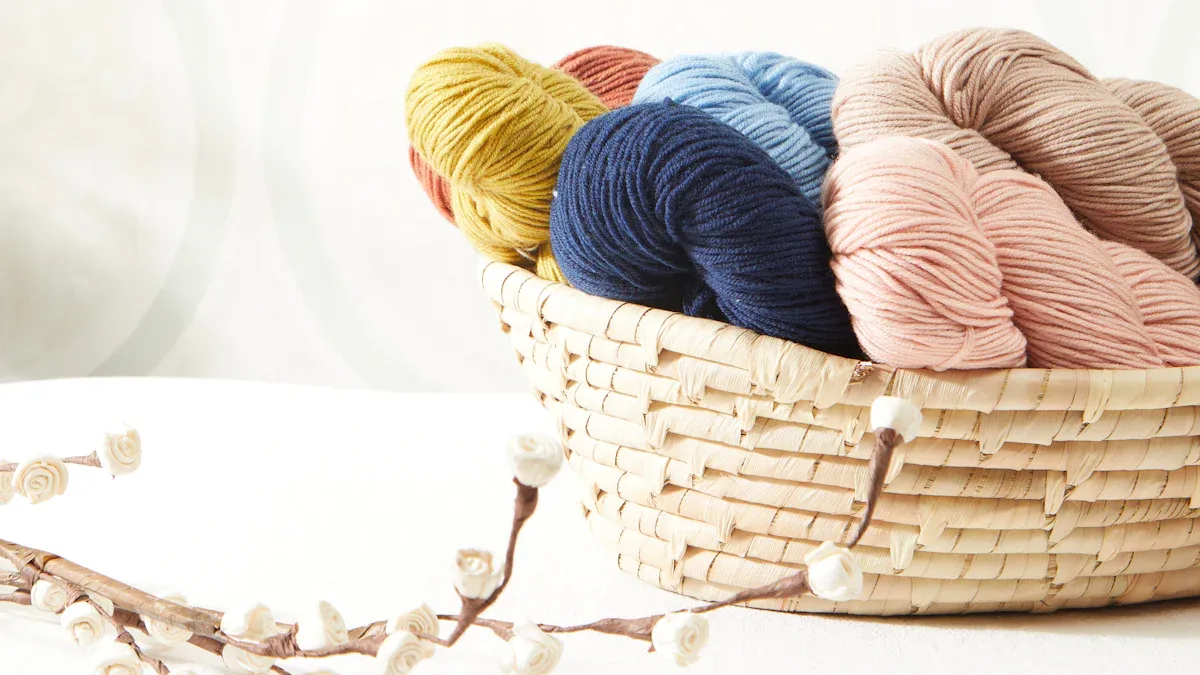
Imagine finishing a sweater, only to find it itchy or losing its shape after a few wears. The wool yarn you pick can change everything. When you choose the best quality wool for knitting, you get warmth, softness, and a project that lasts. Studies show that good wool yarn keeps you cozy, holds its shape, and looks great wash after wash. You want every one of your knitting projects to feel and look amazing, right? Let’s make sure you always pick the best.
Key Takeaways
Pick good wool yarn like merino, alpaca, or cashmere. These yarns feel soft and warm. They also last a long time in your knitting projects. Match the yarn weight and ply to your pattern. This helps your project fit right and makes stitches easy to see. Always make a swatch before you start. This checks your gauge and shows how the yarn acts after washing. Touch the yarn before you buy it. This helps you test if it is soft and not itchy. This is important for things worn close to your skin. Follow the care instructions for your yarn. This keeps your knitted items looking nice and helps them last longer.
Why Yarn Choice Matters
Project Results
When you start a knitting project, the yarn you choose shapes everything. The right kind of yarn helps your work look polished and last longer. If you pick high quality wool yarn, you get softness, warmth, and a fabric that keeps its shape. If you use synthetic or lower quality yarns, you might save money, but you often lose out on comfort and durability.
Here’s how different yarns stack up:
Yarn Type | Benefits & Qualities | Drawbacks & Effects on Projects |
|---|---|---|
High Quality Wool | Soft, warm, elastic, durable, keeps shape, breathable | Needs gentle care, higher cost, may pill |
Merino Wool | Extra soft, warm, great for sensitive skin | Higher cost, gentle care, can pill |
Synthetic (Acrylic) | Affordable, easy care, many colors | Less breathable, less stitch definition, not natural |
Lower Quality Wool | Can be improved for strength | Less ideal for wearables, lower comfort |
You want your finished piece to look great and feel good. Yarn properties like weight, ply, and texture decide how your project turns out. If you match the yarn to your pattern, you avoid sagging, stiffness, or poor drape. Your project will fit better and last longer.
Comfort & Durability
Comfort matters, especially for things you wear close to your skin. Wool yarn feels soft and warm, making it perfect for scarves and sweaters. Yarn properties like fiber type, twist, and thickness change how your project feels and wears over time.
Thicker yarns and more fuzzy fibers keep you warmer.
Some fibers, like cotton, feel soft but can lose shape.
Blends can balance softness, strength, and easy care.
If you want a cozy, long-lasting piece, pay attention to yarn properties. The right kind of yarn makes your knitting project comfortable and strong. You’ll enjoy wearing or using your finished item for years.
Fiber Content
Best Quality Wool for Knitting
If you want the best wool for knitting, check the fiber content. The fiber you pick changes how your project feels. It also affects how warm and strong it is. Some yarns feel soft and cozy. Others are stronger or look shiny.
Here are some top choices for the best wool for knitting:
Wool Type | Softness | Warmth | Durability & Other Qualities |
|---|---|---|---|
Merino | Extremely soft, ideal for next-to-skin wear | Very warm, elastic | Good elasticity, widely available |
Cashmere | Unmatched softness, luxurious | Excellent insulation | Delicate, expensive, requires gentle care |
Alpaca | Soft and hypoallergenic | Highly insulating and warm | Durable, suitable for sensitive skin |
Mohair | Soft with a halo effect | Lightweight warmth | Can be itchy for sensitive skin, often blended |
Lambswool | Balanced softness and elasticity | Warm | Versatile for various projects |
Shetland | Fine texture | Warm | Durable, good for traditional patterns |
Corriedale | Soft and warm | Warm | Durable, versatile for knitting and felting |
Angora | Extremely soft and fine | Warm | Delicate, often blended for durability |
Merino is a top choice for knitting. It is soft, warm, and stretchy. Merino is great for scarves, hats, and sweaters. Cashmere is even softer and warmer. But it costs more and needs gentle washing. Alpaca is warm and strong. It is good for cold weather. Mohair looks fuzzy but can feel itchy. Lambswool and Shetland are nice for classic projects. Corriedale is soft, warm, and strong. Many knitters like it.
Blends & Alternatives
You might find wool blend yarns in stores. These mix the best wool for knitting with other fibers. A wool blend can have cotton, silk, nylon, or acrylic. Each fiber adds something special. Cotton makes yarn cooler and lets air through. Silk gives shine and makes yarn smooth. Nylon and acrylic make yarn stronger and easier to wash.
A wool blend gives you comfort and strength. It lasts longer and is easier to care for. For socks or baby clothes, try merino and nylon. For a soft shawl, use merino and silk. For a warm sweater, pick a merino or alpaca blend.
Tip: Pick your fiber content for the season and project. Use animal fibers like merino, alpaca, or cashmere for winter. Try plant blends for summer. Always read the label to know what’s in your yarn.
Yarn Weight
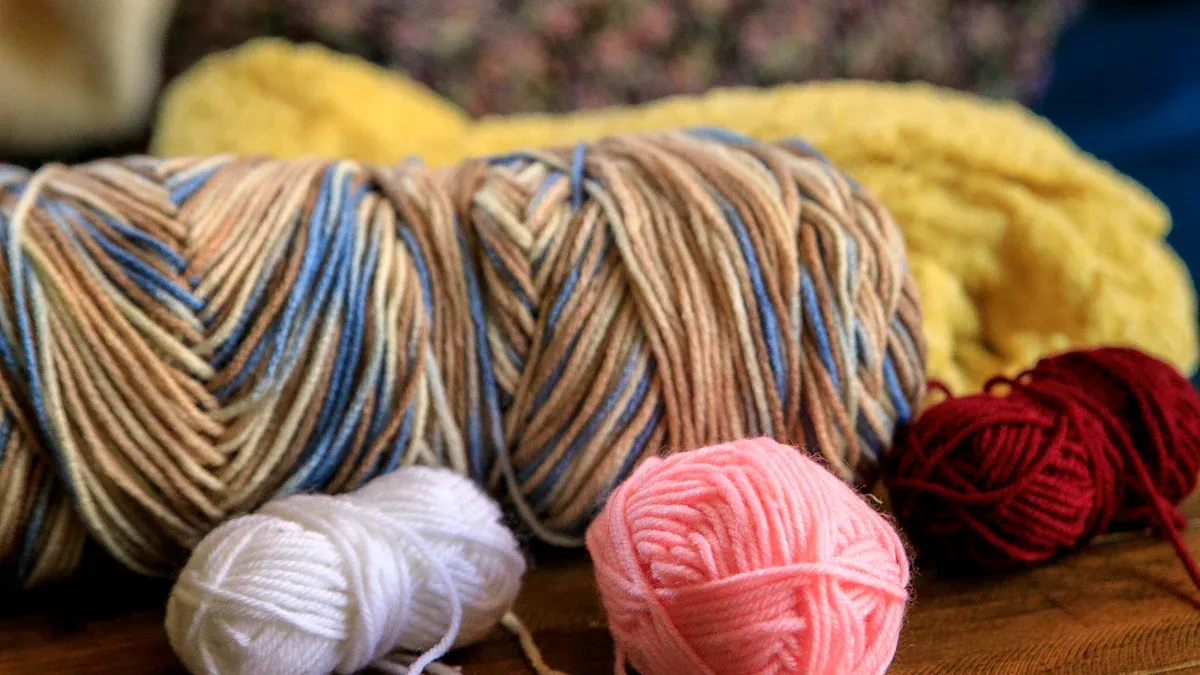
Choose Yarn for Knitting
When you choose yarn for knitting, yarn weight is one of the first things you notice. Yarn weight tells you how thick or thin the yarn is. This choice changes how your project feels, looks, and fits. Thicker yarns make warm, chunky scarves or blankets. Thinner yarns create light, airy shawls. If you want your project to drape softly or hold its shape, yarn weight matters.
Here’s a handy table to help you compare yarn weights:
Category | Description | Thickness | Gauge Range (sts/10 cm) | Needle Size (mm) | Ply Count |
|---|---|---|---|---|---|
Lace | Very fine yarn | Lace | 32-40 | 2.0-2.75 | 2-4 |
Super Fine | Sock, fingering, or baby yarn | Fingering | 28-32 | 2.25-3.25 | 2-4 |
Fine | Sport yarn | Sport | 24-27 | 3.25-3.75 | 2-4 |
Light | DK or light worsted yarn | Light worsted | 22-24 | 3.75-4.5 | 3-5 |
Medium | Worsted or afghan yarn | Worsted | 20-22 | 4.5-5.5 | 4-6 |
Bulky | Chunky yarn | Chunky | 18-20 | 5.5-6.5 | 5-7 |
Super Bulky | Roving yarn | Super bulky | 14-16 | 6.5 and up | 6-8 |
Jumbo | Roving yarn | Jumbo | 12-14 | 8 and up | 7-9 |
You can also spot yarn weight by looking for a number symbol (0-7) on the label. Each number matches a yarn thickness. For example, 0 means laceweight, and 7 means jumbo. When you choose yarn for knitting, match the weight to your pattern. Socks need super fine yarn. Cozy hats or blankets use bulky or super bulky yarn. If you mix yarn weights, your fabric will change. Two laceweight yarns together can act like a DK yarn.
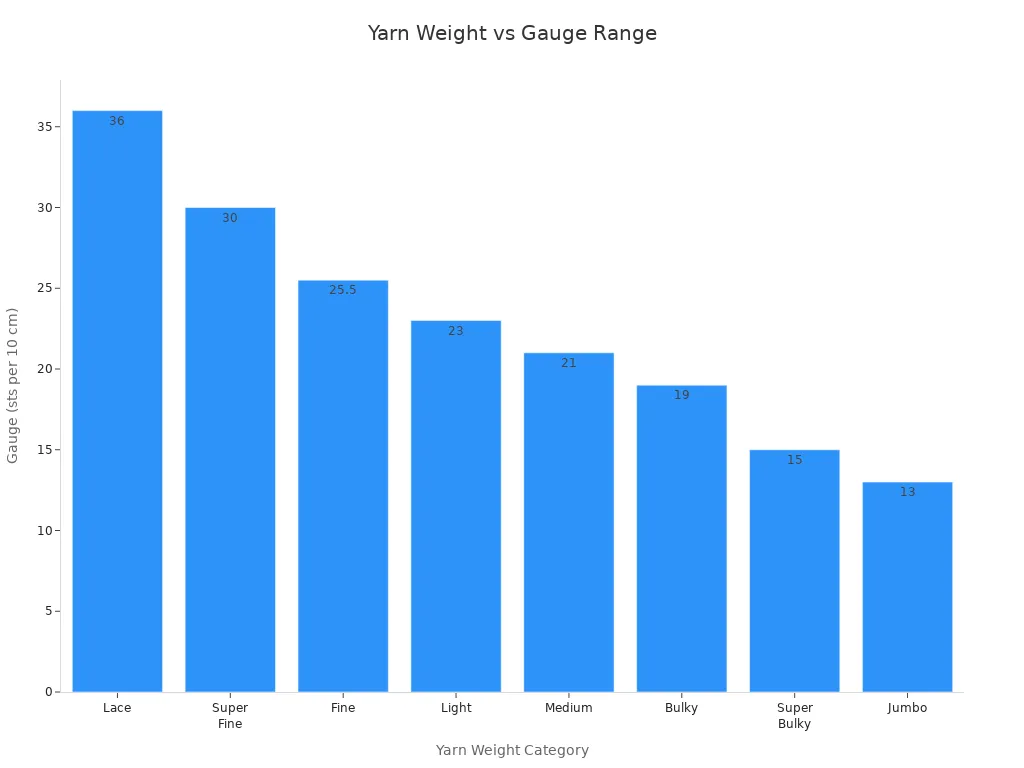
Tip: Always check the yarn label for weight, gauge, and recommended needle size. This helps you choose yarn for knitting that fits your project.
Swatching & Gauge
Before you start your knitting project, make a swatch. Swatching means knitting a small square with your chosen yarn and needles. This step checks your gauge, or how many stitches fit in a certain space. If your gauge is off, your project might turn out too big or too small.
Swatching helps you see if your stitches match the pattern’s size.
If your swatch is too tight, try bigger needles. If it’s too loose, use smaller needles.
Wash and block your swatch. This shows how the yarn will behave after you finish your project.
Swatching also lets you practice with new types of yarn.
When you choose yarn for knitting, swatching saves you time and trouble. It helps you avoid surprises and makes sure your finished piece fits just right.
Ply & Construction
Strength & Texture
When you pick wool yarn, you might notice words like “single-ply,” “two-ply,” or “four-ply” on the label. Ply means how many strands twist together to make the yarn. This number changes how your knitting feels and looks.
Three-ply yarns feel strong and round. They make smooth, even stitches. You might use them for socks or gloves that need to last.
Four-ply yarns are even denser and stronger. They show off textured stitches and cables. These work well for hats, toys, or blankets.
More plies usually mean more strength and a smoother yarn. Your stitches look neat and clear.
Fewer plies, like single-ply yarn, give a soft, fluffy feel. They highlight delicate stitch patterns, like lace. These yarns make lighter, airier fabrics.
You get different textures with different plies. Single-ply yarns feel soft and cozy. They show off hand-dyed colors and look great in simple stitches. Multi-ply yarns give you crisp stitch definition. They help cables and textured patterns stand out.
Tip: If you want your cables to pop or your stitches to look sharp, try a three- or four-ply yarn.
Durability Factors
Durability matters, especially for things you use a lot. More plies make yarn stronger and less likely to break or pill. Multi-ply yarns hold up better in high-wear spots, like the heels of socks or the elbows of sweaters. They also keep their shape after washing.
Single-ply yarns feel soft but can wear out faster. They may pill or stretch, especially in items you use every day. These yarns work best for scarves, shawls, or hats that don’t get much friction.
Low-quality wool yarn often pills and loses strength when wet. It can feel scratchy and wears out quickly in places that rub a lot. You need to handle these yarns with care to keep your project looking good.
Yarn Type | Best For | Durability Level | Stitch Definition |
|---|---|---|---|
Single-ply | Lace, shawls, scarves | Low | Soft, delicate |
Two/Three-ply | Socks, gloves, sweaters | High | Crisp, defined |
Four-ply | Cables, toys, blankets | Very High | Bold, textured |
Choose your yarn ply based on what you want to knit. If you want strength and clear stitches, go for multi-ply. If you want softness and a gentle look, single-ply is a good pick.
Softness & Feel
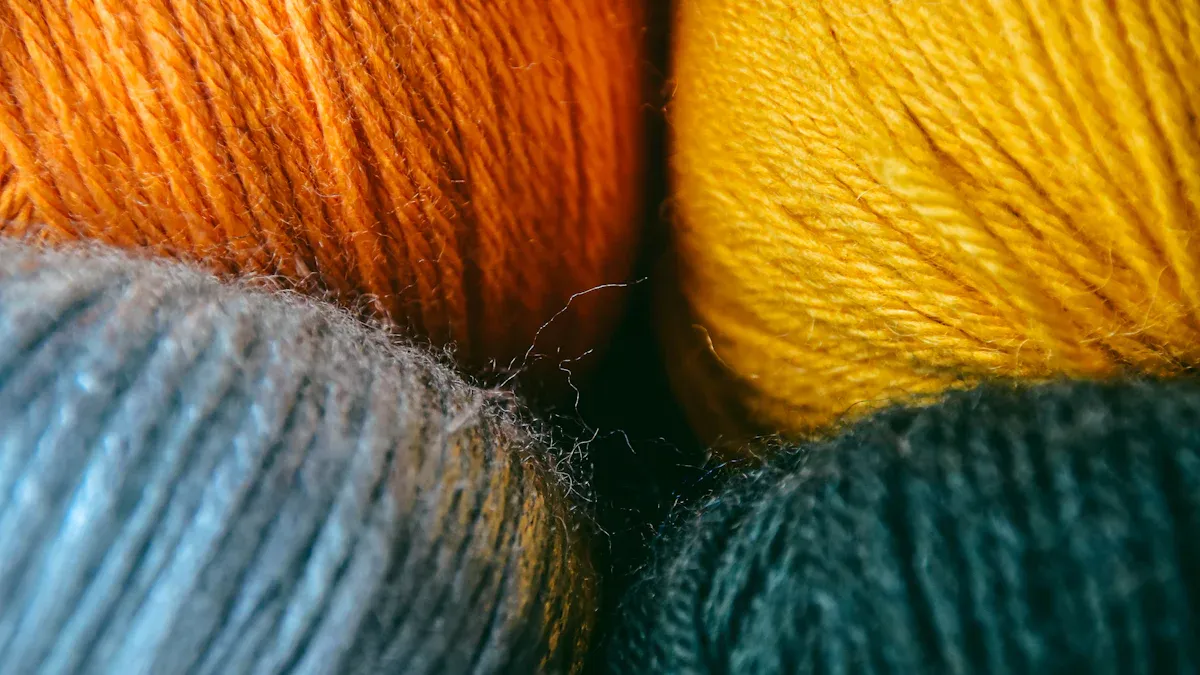
Touch Test
When you shop for wool yarn, nothing beats feeling it with your own hands. You want to know if the yarn feels soft or scratchy before you buy it. Here are some ways you can check softness in-store:
Gently squeeze the yarn ball. Does it feel smooth or rough against your skin?
Rub a strand on your wrist or neck. These spots are sensitive, so you’ll notice any itchiness right away.
Look at the yarn. Fuzzy yarns often feel softer, while smooth yarns might feel a bit firmer.
Remember, the label might mention the micron count, but that number doesn’t always tell you how the finished yarn will feel. Spinning style and treatments can change the texture a lot.
Some yarns feel rough at first because of spinning oils. After washing, they can soften up.
If you can, visit a local yarn shop. You get to touch the yarn and see the real colors. This helps you pick something that feels just right and is easy to work with.
Tip: Online shopping is handy, but nothing replaces the touch test for softness!
End Use Considerations
Think about what you want to make. The softness and feel of your yarn should match your project’s needs. Here’s how different yarns fit different uses:
Wool yarns are warm and soft. They work well for sweaters, hats, and scarves. Some people have wool allergies, so check before making gifts.
Acrylic yarn is great for blankets, toys, and kids’ clothes. It’s soft, machine-washable, and stands up to lots of use.
Cotton yarn feels cool and absorbs moisture. It’s perfect for dishcloths, summer tops, and household items, but it can be heavier and less stretchy.
You also need to balance softness with durability. Softer yarns like merino, cashmere, or angora feel amazing but need gentle care. More durable yarns, like standard wool or superwash wool, last longer and are easier to wash.
Aspect | More Durable Wool Yarns (Standard, Superwash) | |
|---|---|---|
Softness | Very soft, great for baby items, scarves | Less soft, good for everyday wear |
Durability | Delicate, may pill or wear out faster | Strong, holds shape, resists pilling |
Care | Hand wash, gentle handling | Often machine washable, easy care |
Cost | Usually more expensive | More budget-friendly |
Best For | Next-to-skin, delicate projects | Sweaters, blankets, home decor |
Choose your yarn based on who will use the item and how often it will get washed. This way, your finished project will feel good and last a long time.
Durability & Quality
Fiber Length & Fineness
When you want your knitting to last, pay attention to fiber length and fineness. Longer fibers make yarns stronger and smoother. They help your projects resist fuzz and pilling. Short fibers often stick out from the yarn, making your sweater or hat look fuzzy and worn after a few uses. You might notice more little balls, or pills, on the surface when you use yarn with lots of short fibers.
Finer fibers feel soft and cozy. They pack together well, which helps the yarn stay strong and even. But there’s a trade-off. Finer fibers can sometimes pill more because they tangle easily on the surface. Wool’s natural crimp adds bulk and helps fibers lock together, so your project stays fluffy and less likely to pill. If you want a sweater that looks good after many wears, choose yarns with long, fine fibers and a bit of natural crimp.
Best Yarn for Every Project
You want your knitted items to keep their shape and color, especially if you’re making something fitted like a hat or sweater. Fiber memory is what helps your project bounce back after stretching. Wool is famous for its memory. It snaps back into place, so your cuffs and collars don’t get baggy. Some modern yarns even use special fibers that remember their shape, making them perfect for activewear or anything that needs to fit well.
If you want your colors to stay bright, blends with acrylic can help. Acrylic fibers boost colorfastness and make your project more resistant to wear and tear. Pure wool holds dye beautifully and stays vibrant, but blends can last even longer and resist fading. For the best yarn for every project, think about how much wear your item will get, how often you’ll wash it, and how important shape and color are to you. Choose yarns that match your needs, and your knitting will look great for years.
Reading Yarn Labels
Best Knitting Yarns
When you stand in front of a wall of yarn, the labels can feel confusing. You want to pick the best knitting yarns for your project, but how do you know what all those numbers and symbols mean? Start by checking the fiber content. This tells you if the yarn is wool, alpaca, cashmere, or a blend. Fiber content affects how warm, soft, or strong your finished piece will be.
Next, look at the yarn weight. This helps you match the yarn to your pattern and get the right thickness. The label also shows yardage or meters, so you can buy enough for your project. Always check the dye lot number. If you use yarn from different dye lots, your project might have patches of different colors. For the best knitting yarns, buy all your skeins from the same dye lot.
Care instructions are important too. Some yarns need hand washing, while others can go in the machine. If you ignore these, your project could shrink or felt. The best knitting yarns have clear labels that help you avoid mistakes and keep your work looking great.
Tip: Compare labels side by side before you buy. This helps you spot differences in fiber, weight, and care.
Key Symbols
Yarn labels use symbols to give you quick information. Here are some key things to look for:
Washing symbols: Show if you can machine wash, hand wash, or need special care.
Ironing and drying symbols: Tell you if you can iron or tumble dry your project.
Recommended needle size: Helps you get the right gauge and stitch size.
Tension/gauge box: Shows how many stitches and rows fit in a set space.
Dye lot number: Keeps your colors even across your project.
Batch or manufacturing codes: Help with quality control and consistency.
Special treatment icons: Indicate if the yarn is superwash, mercerized, or has other finishes.
Many knitters make mistakes by ignoring dye lot numbers or care instructions. This can lead to color changes or damage after washing. Always read the label carefully and swatch before you start. This way, you avoid surprises and enjoy a project that looks and feels just right.
Care Requirements
Washing & Maintenance
Taking care of your wool yarn projects keeps them looking great for years. You have two main choices: hand washing or machine washing. Each method works best for different types of wool.
Hand washing is gentle. You use cool water and a mild detergent. Swirl your item softly, soak for a few minutes, then rinse well. Press out water without twisting. Lay your project flat on a towel to dry. This method helps your wool keep its shape and softness.
Machine washing can work for some yarns. Use the delicate or wool cycle, cold water, and a gentle detergent. Always skip the dryer. Air dry flat to avoid shrinking or stretching.
The type of wool yarn you choose matters, too. Superwash wool is treated so you can wash it in a machine. It resists felting and shrinking, making it perfect for baby clothes or socks that need frequent washing. Non-superwash wool keeps its natural feel and warmth but needs more care. You should hand wash these items to avoid felting and damage.
Here’s a quick comparison:
Yarn Type | Care Method | Pros | Cons |
|---|---|---|---|
Superwash Wool | Machine washable | Easy care, resists shrinking | May stretch, less natural |
Non-superwash Wool | Hand wash only | Natural texture, durable | Needs gentle handling |
Tip: If you want easy care, pick superwash wool. For classic feel and long life, choose non-superwash and hand wash.
Shrinkage Risks
Wool can shrink if you use hot water, too much soap, or rough washing. The scales on wool fibers lock together when they get warm and move around. This causes felting and makes your project smaller and stiffer.
To avoid shrinkage:
Always use cold water.
Wash gently, by hand or on a delicate cycle.
Never wring or twist your project.
Lay flat to dry—never use a dryer.
For extra protection, turn items inside out or use a mesh bag in the wash.
Superwash wool helps prevent shrinking, but even these yarns need gentle care. Non-superwash wool needs the most attention. Treat your handmade items kindly, and they’ll stay soft, bright, and the right size for a long time.
Picking the right wool yarn helps your knitting look its best. If you check the fiber content, choose the right weight, and read the label, your projects turn out better. Your knits will feel softer, warmer, and last longer. Try using yarn from brands like Rowan, Malabrigo, or Debbie Bliss for a good result.
Brand | What Makes It Special |
|---|---|
Rowan | Soft, non-itchy, wide color range |
Malabrigo | Bright colors, buttery feel |
Debbie Bliss | Luxury blends, machine washable |
Do you have a favorite yarn? Tell us your top picks or share your knitting stories in the comments!
FAQ
What is the best way to start with knitting yarns for beginners?
You should look for soft, medium-weight yarns. These are easy to handle and show your stitches clearly. Bright colors help you see your work. Try wool blends or acrylic if you want easy care.
How do I handle yarn picking and substitution for a pattern?
Check the yarn weight and fiber content in your pattern. Choose a yarn with similar thickness and stretch. Make a swatch to test the size. This helps your project turn out right.
Can a beginner use luxury wool yarn?
Yes, you can! If you are a beginner, try a small project first. Luxury yarn feels soft and looks beautiful. Start with a hat or scarf to practice before using it for bigger projects.
How do I know if a yarn will itch?
Rub the yarn on your wrist or neck. If it feels scratchy, it might itch when you wear it. Softer yarns like merino or blends are less likely to bother your skin.
What should I do if I run out of yarn before finishing?
Try to buy extra yarn at the start. If you run out, look for the same brand and dye lot. If you cannot find it, use a similar color for stripes or borders. This makes your project unique.




